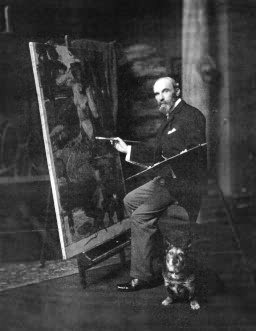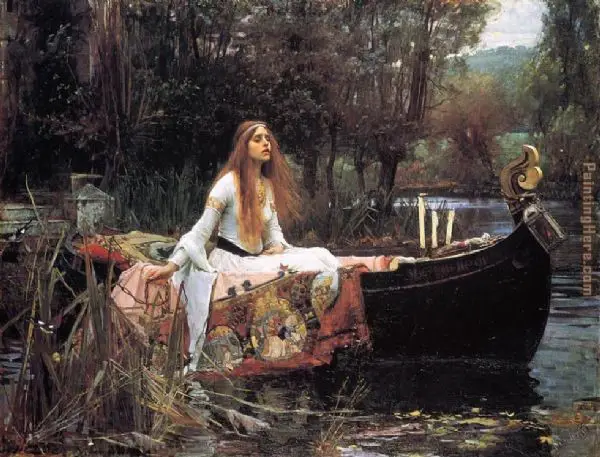John William Waterhouse was a popular late 19th and early 20th-century British painter. He was known for painting in Pre-Raphaelite style. He continued to work in Pre-Raphaelite style after the increase in its popularity due to the Pre-Raphaelite movement of 1848.

He was born in 1849 in Rome, Italy. His father was also a painter by profession. After John’s birth, the Waterhouse family shifted back to Britain in 1850. In England, the Waterhouse family settled in Kensington. John had an early exposure to the world of paintings by observing his father work. In fact, he even helped his father in his studio whilst he was painting. He was fondly called as ‘Nino’.

He married Esther Kenworthy in 1883. Esther’s father was an artist from Ealing. Esther was also an artist by profession like him. Esther had painted some paintings to her credit and they were also exhibited at different places. John and Esther had two children. However, both of them died when they were very young. Esther died in 1944, 27 years after the death of her husband. At the time of her death, she was living in a nursing home. However, apart from this, very little information is available about his personal life.
John Waterhouse’s early works were in classical style and were even exhibited at places like Royal Academy (his alumni), Dudley Gallery, etc. His paintings were a merger of different styles like classicism, fantasy, romanticism, etc. His painting “Ariadne” was a precise example of classicism. John’s work was regarded as being unique during the Victorian period. Waterhouse had the natural inclination for using the appropriate color schemes for his paintings. It was this color schemes that distinguished him as a painter from his contemporaries. Apart from this, he always gave emphasis to light.
He went to the Royal Academy in 1870 for learning arts. He learnt some of his artistic skills in Italy. Apart from painting, John also worked as an associate of the Royal Academy in 1885. He also taught at the St. John’s Wood Art school between 1892 and 1913. In 1895, he was a full member of the Academy.
John William Waterhouse is known to have painted over a hundred paintings. His early works were inspired by artists like Sir Lawrence Alma-Tadema and Leighton. It is a known fact that John often travelled to Rome, his birthplace to paint. Waterhouse was famous for painting scenes influenced by legends and mythology. He was even known for depicting women or girls as the subject of his paintings. These women or girls chosen as subjects for his paintings were those who suffered tragedy or were repressed. His paintings were mostly done in oil paint. “Sleep and his Half-Brother Death” painted in the year 1874 was his first work that was exhibited at the Royal Academy. In 1883, he was elected as
He was even known for depicting women or girls as the subject of his paintings. These women or girls chosen as subjects for his paintings were those who suffered tragedy or were repressed. His paintings were mostly done in oil paint. “Sleep and his Half-Brother Death” painted in the year 1874 was his first work that was exhibited at the Royal Academy. In 1883, he was elected as
He was even known for depicting women or girls as the subject of his paintings. These women or girls chosen as subjects for his paintings were those who suffered tragedy or were repressed. His paintings were mostly done in oil paint. “Sleep and his Half-Brother Death” painted in the year 1874 was his first work that was exhibited at the Royal Academy. In 1883, he was elected as a painter of watercolors at the Royal Academy. However, he resigned from that post in 1889.
“Consulting the Oracle” was one of his paintings that was purchased by Sir Henry Tate in the year 1886. This event truly marked him as a painter. One of his best-known paintings was “The Lady of Shallot” and the same was completed in 1888. This painting was inspired by Tennyson’s poem bearing the same title. This painting, in particular, was painted in three different versions. Each painting depicts a different version of Elaine, the main character of the painting.
One of his paintings known as “Mariamne” has been exhibited in many parts of England. In the later part of the 19th century, John Waterhouse had begun exhibiting portraits. John kept himself busy and continued to paint until the last days. “The Enchanted Garden” was his last painting. However, it was left incomplete as John passed away whilst working on it. Another painting of John was titled as “Circa Invidiosa” which was completed in 1892. “St. Eulalia” (1885) was another painting that was considered to be his best work. The painting is now kept at the Tate Gallery.
His paintings like “Fair Rosamund” portray scenes from the Middle Ages. “Ophelia”, John’s another popular painting shows the final moments in a women’s life before she dies. Some of his other work includes “The Magic Circle” completed in 1886, “La Belle Dame Sans Merci” and “Cleopatra”.
John William Waterhouse died in 1917 in London. He is buried at the Kensal Green Cemetery in London. During the final years of his life, he was suffering from cancer and it attributed to his death. He was counted among the last few painters who used subjects to paint their paintings. He drew inspiration for his paintings from Bible, history, poems of famous poets like those of John Keats and Lord Alfred Tennyson.
